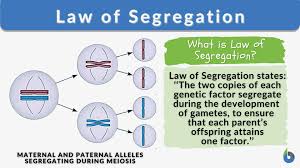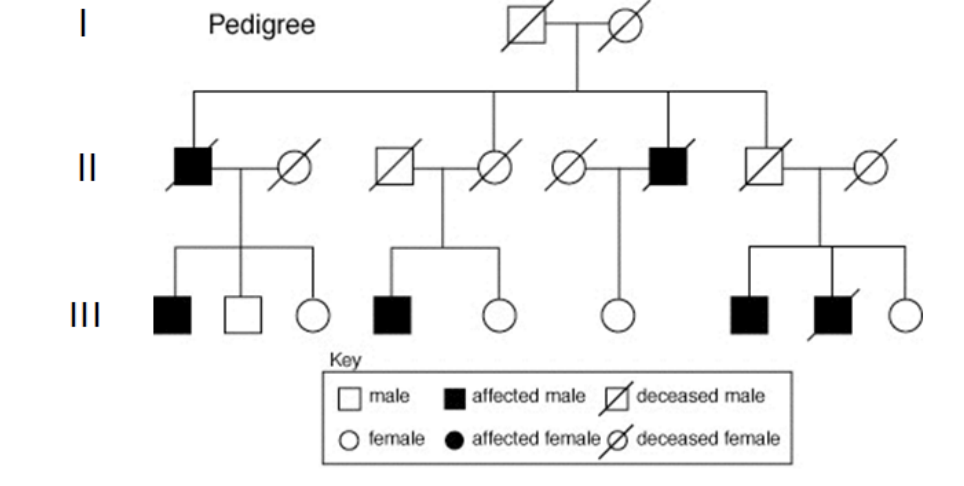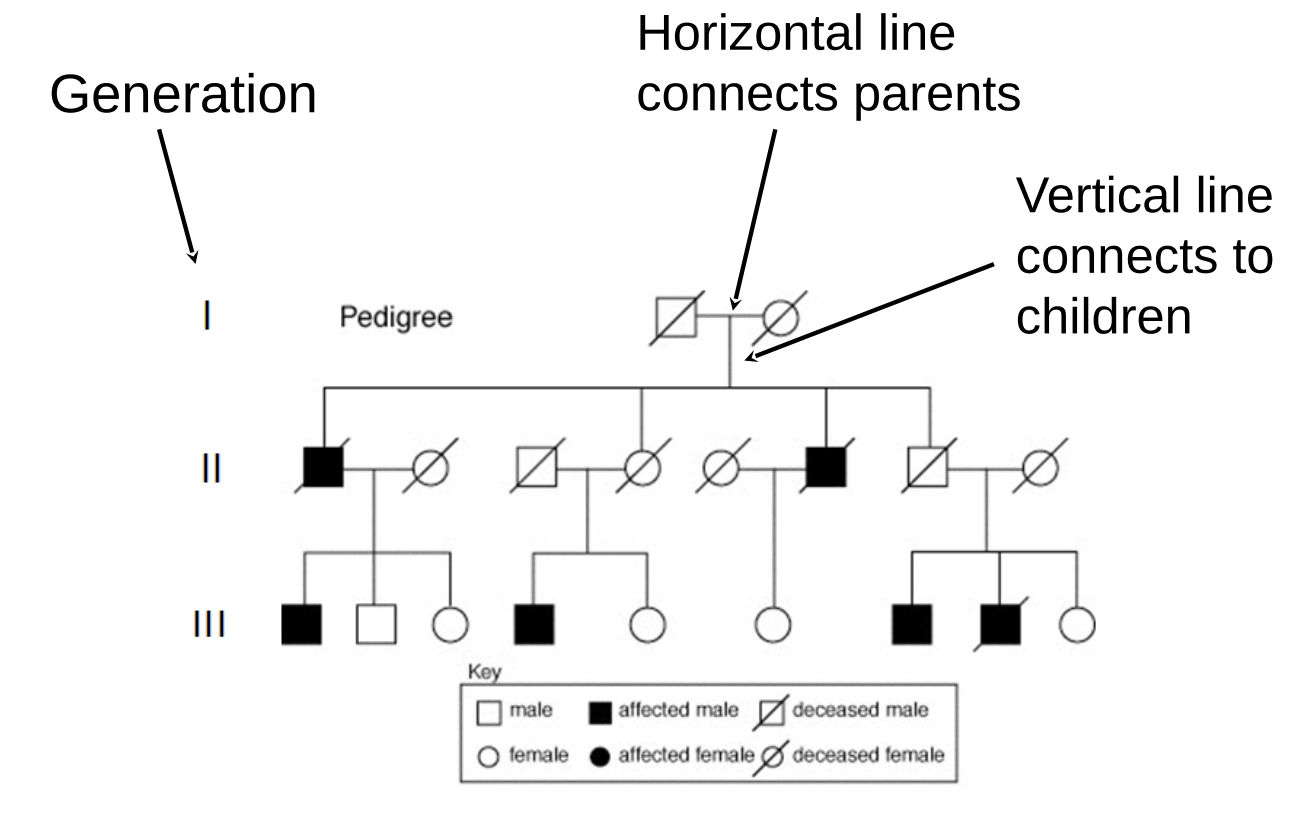bio unit 5: all topics
1/96
Earn XP
Description and Tags
unit 5: heredity
Name | Mastery | Learn | Test | Matching | Spaced |
|---|
No study sessions yet.
97 Terms
genetics
the study of heredity and hereditary variation
heredity
the transmission of traits from one generation to the next
genes
segments of DNA that code for basic units of heredity. traits passed through genes from parents to offspring, and the offspring acquire genes from parents by inheriting chromosomes
traits —> genes —> chromosomes
asexual reproduction
single individual
no fusion of gametes
clones: offsprings are exact copies of parent
mutations are the ONLY source of variation
can produce asexually through mitosis
sexual reproduction
two parents (male/female)
offspring are unique combinations of genes from parents
genetically varied from parents and siblings
homologous chromosomes
a pair of chromosomes (same size, length, centromere position) that carry the same genetic information
*one is inherited from mom and one is inherited from dad
karyotypes
a display of chromosome pairs ordered by size and length
somatic (body) cells
diploid, or 2n (two complete sets of each chromosome)
humans: 2n=46
gametic (sex) cells
haploid, or n (one set of each chromosome)
humans (sperm and eggs): n =23
types of chromosomes
autosomes
sex chromosomes
DNA is packaged in chromosomes in eukaryotes
autosomes
chromosomes that do not determine sex (humans have 22 pairs)
sex chromosomes
X and Y
eggs: X (humans: 22+X)
sperm: X or Y (humans: 22 + X or 22 + Y)
**all sexually reproducing organisms have both a diploid and a haploid number
life cycle
sequence of stages in the reproductive history of an organism from conception to its own reproduction
*fertilization and meiosis alternate in sexual life cycles
fertilization
when a sperm cell (haploid) fuses with an egg (haploid) to form a zygote (diploid)
meiosis
a process that creates haploid gamete cells in sexually reproducing diploid organisms. results in daughter cells with HALF the number of chromosomes as the parent cell
**involved TWO rounds of division: meiosis I and meiosis II
example of meiosis
humans: diploid, 2n=46
meiosis produces sperm and eggs that are HAPLOID: n=23
mitosis vs. meiosis
both processes are similar but have some key differences
mitosis (overview)
occurs in somatic cells
1 division
results in 2 diploid daughter cells
daughter cells are genetically identical
meiosis (overview)
forms gametes (sperm/egg)
2 divisions
results in 4 haploid daughter cells
each daughter cell is genetically unique
key events in meiosis
prophase I: synapsis and crossing over
metaphase I: tetrads (homologous pairs) line up at the metaphase plate
anaphase I: homologous pairs separate
meiosis I: interphase
cell goes through G1, S (DNA is copied), and G2
meiosis I: prophase I
synapsis: homologous chromosomes pair up and physically connect to each other forming a tetrad
crossing over (recombination) occurs at the chiasmata and DNA is exchanged between the homologous pairs
a. each chromatid that is produced has a unique combination of DNA
nuclear envelope breaks down. the centriole pairs start to move to opposite poles and the chromosomes condense
meiosis I: metaphase I
the spindle has formed completely
independent orientation: tetrads line up at the metaphase plate (line up in the middle of the cell)
meiosis I: anaphase I
spindle fibers begin to contract
pairs of homologous chromosomes separate and pulled by centromeres to the poles
a. sister chromatids are still attached
meiosis I: telophase I
nuclear envelopes start to reform around the groups of chromosomes
chromosomes start to decondense back into chromatin
meiosis I: cytokinesis
the cytoplasm and nuclei physically divide
there is now a haploid set of chromosomes in each daughter cell
meiosis II: prophase II
nuclear envelope breaks down
centriole pairs start to move to opposite poles and the chromosomes condense
NO crossing over, spindle starts to form
meiosis II: metaphase II
chromosomes line up in the middle of the cell
a. because of crossing over in meiosis I, the chromatids are unique
spindle has formed completely
meiosis II: anaphase II
spindle fibers begin to contract
sister chromatids get separated as they are pulled by their centromere to the poles
meiosis II: telophase II
nuclear envelopes start to reform around the groups of chromosomes
chromosomes start to decondense back into chromatin
meiosis II: cytokinesis
cytoplasm physically divides
4 haploid cells are formed —> each daughter cell is genetically unique
cells are now in interphase
meiosis review
early meiosis I: parent cell —> 2n = 4
end of meiosis II: each daughter cell —> n=2
how does meiosis lead to genetic variation?
crossing over
independent assortment of chromosomes
random fertilization
crossing over
produces recombinant chromosomes: they exchange genetic material
independent assortment of chromosomes
chromosomes are randomly oriented along the metaphase plate during metaphase I
each can orient with either the maternal or paternal chromosomes closer to a given pole
random fertilization
any sperm can fertilize any egg
meiosis + fertilization
meiosis followed by fertilization ensures genetic diversity in sexually reproducing organisms and provides genetic variation that plays a role in natural selection
mendelian genetics
Gregor Mendel studied inheritance and created two laws that can be applied to the study of genetics
common ancestry
DNA and RNA carry genetic information
the genetic code is shared by all living systems
Gregor Mendel
Austrian monk who experimented on pea plants and discovered the basic principles of heredity
why pea plants for experimentation?
many varieties
controlled mating
relatively short generation time
pea plant traits
mendel tracked characteristics that came in two forms:
color
seed shape
true breeding
organisms that produce offspring of the same variety over many generations of self pollination
example: true breeding purple pea plants will ONLY produce purple offspring with self pollination
generations
P generation: true-breeding parental generation
F1 generation (first filial): hybrid offspring of P generation
F2 generation (second filial): offspring of the F1 generation
punnett squares
diagrams used to predict the allele combinations of offspring from a cross with known genetic compositions
capital letters = dominant traits
lower case letters = recessive traits
homozygous
an organism that has a pair of identical alleles for a character
homozygous dominant: AA
homozygous recessive: aa
heterozygous
an organism has two different alleles for a gene
ex: Aa
genotype
the genetic makeup (alleles) of an organism
ex: AA, Aa, aa, etc.
phenotype
an organism’s appearance, which is determined by the genotype
ex: purple, white, smooth, wrinkled, etc.
testcross
help to determine if the dominant trait is homozygous dominant or heterozygous
principles of heredity
law of segregation
law of independent assortment
law of segregation
the two alleles for the same trait separate during gamete formation and end up in different gametes
example: each gamete for P generation will contain one allele for flower color (in this case they are true breeding so every gamete has the same allele)

law of independent assortment
genes for one trait are NOT inherited with genes of another trait:
instead of following one trait in his crosses, this time Mendel followed TWO traits (ex: pea pod color AND pea pod shape)
this law only applies to: genes that are located on different chromosomes (NOT homologous) OR genes that are very far apart on the same chromosome
mendel’s discoveries
mendel notices that the cross between purple and white true breeding pea plants produced ONLY purple F1 offspring
**white characteristic did NOT disappear, it came back in the F2 generation
dominant vs. recessive
mendel hypothesized that the purple flower must be a dominant trait to the white flower, which is a recessive trait
a. performed same crosses for each of the 7 characteristics of pea plants and found the same results
found that F2 generation was ALWAYS a 3:1 ratio
mendel’s model
explains the 3:1 generation in the F2 generation:
alternative versions of genes (alleles) account for variations in inherited characteristics
for each character, an organism inherits TWO copies of a gene (TWO alleles), one from each parent
if two alleles at a locus differ, then the dominant allele determines the appearance and the recessive allele has no noticeable effect
alleles
alternative versions of a gene
(somatic cells are diploid, they contain TWO copies of each chromosome)
monohybrid crosses
a cross between the F1 hybrids (ex: Bb x Bb)
the law of segregation was determined by doing crosses between true-breeding plants which produced F1 hybrids, known an monohybrids (ex: BB x bb produce F1 that are all Bb)
dihybrid crosses
a cross between F1 dihybrids (ex: YyRr x YyRr) —> produces a 9:3:3:1 phenotypic ratio
the law of independent assortment was determined by doing crosses between plants that were true breeding for two traits, which produced F1 hybrids known as dihybrids (ex: YYRR x yyrr, all F1 dihybrids would be YyRr)
how to solve genetic problems
write down symbols for the alleles (sometimes they are given)
write down genotypes given
a. if phenotypes are given, then write down the possible genotypes
determine what the problem is asking, and write out the cross as: [genotype] x [genotype]
set up the punnett square
laws of probability
the laws of segregation and independent assortment reflect rules of probability:
multiplication rule
addition rule
multiplication rule
the probability that two or more independent events will occur together in some specific combination
ex: if you flip a coin twice, what is the probability that it will land heads up both times? ½ x ½ = ¼
addition rule
addition rule: the probability that two or more mutually exclusive events will occur
ex: what is the chance of rolling a dice and it lands on a 1 OR 6? 1/6 + 1/6 = 1/3
pedigrees
family trees that give a visual of inheritance patterns of particular traits

reading pedigrees
if a trait is dominant, one parent must have the trait (**dominant traits do not skip a generation)
if a trait is X-linked, then males are more commonly affected than females

why do some traits not follow the ratios predicted by Mendel’s laws?
varying degrees of dominance
many traits are produced through multiple genes
some traits are determined by genes on the sex chromosomes
some genes are adjacent or close to one another one the same chromosome, causing them to segregate as a unit
some traits are the result of non-nuclear inheritance (ex: chloroplast and mitochondrial DNA)
complete dominance
homozygous dominant and heterozygous individuals are phenotypically the same; the kinds of traits Mendel worked with in his experiments
degrees of dominance
incomplete dominance
codominance
multiple alleles
incomplete dominance
neither allele is fully dominant; F1 generation has a phenotype that is a mix of those of the parental generation
ex: red flowers x white flowers = pink offspring
codominance
two alleles that affect phenotype are both expressed
ex: human blood group, type AB blood (A and B are both expressed)
multiple alleles
genes that exist in forms with more than two alleles
ex: human blood group, alleles- IA, IB, i
multiple genes
in many cases, two or more genes are responsible in determining phenotypes:
epistasis
polygenic inheritance
epistasis
the phenotypic expression of a gene at one locus affects a gene at another locus
ex: coat color in mice- one gene codes for pigment and a second gene codes for whether or not that pigment will actually show up
polygenetic inheritance
the effect of two or more genes acting on a single phenotype
ex: height, human skin color
sex-linked genes
a gene located on either the X or the Y chromosome:
Y-linked genes: genes found on Y chromosome
* very few Y-linked genes, so very few disorders
X-linked genes: genes found on X chromosome
inheritance of X-linked genes
fathers can pass X-linked alleles to all of their daughters, but NONE to their sons
mothers can pass X-linked alleles to BOTH daughters and sons
recessive X-linked traits
if an X-linked trait is due to an recessive allele:
females will only express the trait if the are homozygous
because males only have one X chromosome, they will express the trait if they inherit it from their mother
a. called hemizygous
b. due to this males are much more likely to have an X-linked disorder
X-linked disorders
duchenne muscular dystrophy
a. progressive weakening of muscles
hemophilia
a. inability to properly clot blood
color blindness
a. inability to correctly see colors
X-inactivation
females inherit two X chromosomes (double than males); during development, most of the X chromosome in each cell becomes inactive
the inactive X in each cell of a female condenses into a Barr body (helps to regulate gene dosage in females)
genetic recombination
production of offspring with a new combination of genes from parents
parental types: offspring with parental phenotype
recombinants: offspring with different phenotypes than parents
linked genes
genes are located near each other on the same chromosome that tend to be inherited together
causes of genetic variation
meiosis and random fertilization generate genetic variation in offspring due to:
independent assortment of chromosomes
crossing over in meiosis I
any sperm can fertilize any egg
linked genes: crossing over
during crossing over, chromosomes from one paternal chromatid and one maternal chromatid exchange corresponding segments; crossing over helps to explain why genes become separated during meiosis:
the further apart two genes are on the same chromosome, the higher the probability that a crossing over event will occur and the higher recombination frequency
mapping distance
scientists can map genes and their locations on chromosomes
linkage map
genetic map that is based on recombination frequencies
map units: distance between genes
ONE map is equivalent to a 1% recombination frequency; it expresses the relative distances along chromosomes
50% recombination means that the genes are far apart on the same chromosome or on two different chromosomes
non-nuclear DNA
some traits are located on DNA found in the mitochondria or chloroplasts; both chloroplasts and mitochondria are randomly assorted to gametes and daughter cells
non-nuclear DNA: animals
in animals, mitochondria are transmitted by the egg, NOT the sperm; therefore, ALL mitochondrial DNA is maternally inherited
non-nuclear DNA: plants
in plants, mitochondria and chloroplasts are transmitted in the ovule, NOT the pollen; therefore, both mitochondrial and chloroplast determined traits are maternally inherited
statistical analysis: chi square
a form of statistical analysis used to compare the actual results (observed) with the expected results
helps to:
determine whether the data obtained experimentally provides a “good fit” to the expected data
determine if any deviations from the expected results are due to random chance alone or other circumstances
designed to analyze categorical data
chi square (x²) formula
use the equation to test the “null” hypothesis —> the prediction that the data from the experiment will match the expected results

(reminder): null hypothesis
the hypothesis that says there is no significant different between specified populations and considers any observed difference being due to sampling or experimental error
environmental effects on phenotype
various environmental factors can influence gene expression
phenotypic plasticity
phenotypic plasticity
individuals with the same genotype exhibit different phenotypes in different environments
ex: soil pH can affect flower color, temperature can change coat color in rabbits, UV exposure can increase melanin production in the skin
genetic disorders
some genetic disorders can be linked to:
mutated alleles
a. Tay-Sachs disease
b. sickle cell anemia
chromosomal changes
a. nondisjuction
Tay-Sachs disease
autosomal recessive disease with a mutated HEXA gene:
body fails to produce an enzyme that breaks down a particular liquid
affects central nervous system and results in blindness
sickle cell anemia
autosomal recessive disease with a mutated HBB gene:
sickled cells contain abnormal hemoglobin molecules
nondisjunction
chromosomes fail to separate properly in meiosis I or meiosis II:
karyotyping can detect nondisjunction (ex: down syndrome, 3 copies of chromosome 21)